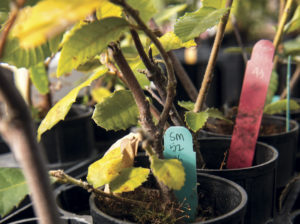In California, the arrival of rain each winter is like spring in other places–dormant plants come back to life, parched hills turn green, trees leaf out. Throw in a three-year drought, and it seems like a wet winter should have us all dancing in the streets.
Maybe so, but not all new growth is a good thing. Rain brings worry for researchers studying the spread of sudden oak death (SOD), which has already killed several million California oaks and tanoaks and infested many more. That’s because the pathogen that causes SOD, Phytophthora ramorum, thrives in moist, mild climates. As Bay Nature reported in 2006, Phytophthora spores spread from tree to tree primarily through wind-driven rain moving throughout the forest canopy. The number of trees newly infected varies widely from year to year; in dry years very few oaks are infected, but in wet years a large number can acquire SOD. Called “wave years,” an El Niño year is a wave year of potential high intensity that, the California Oak Mortality Task Force fears, can result in epidemic spread of P. ramorum.
Related to the Irish potato blight, P. ramorum can also infect over 100 plant species. California bay laurels are the most common host of the pathogen that spread the spores to other plants but do not die themselves. Tanoaks both spread the disease and also die from it, while true oaks cannot spread SOD but can be killed by it.
But there is now a way to prevent sudden oak death–a preventative treatment that can thwart the disease if applied before a tree is infected. According to Katie Palmieri, of the California Oak Mortality Task Force, public outreach is vital. “It’s a preventative treatment, so we need get the word out in a timely way,” she says. “It’s no good if a tree is already infected.” There are currently two ways to apply the treatment–a targeted injection or a spray. The injection means less chemical runoff but more effort, since holes must be drilled into the tree to inject the material. The spray is easier to apply, but it cannot be administered in rain or wind and requires a greater amount of chemicals. Free training sessions (the next on December 9) are being offered at UC Berkeley on how to select trees for treatment and how to properly apply it.
Even if you don’t have land with oaks that need protection, you can help stem the spread of SOD. Soil, water, and organic materials can contain and pass on the SOD pathogen–in an infested area, especially during the rainy season, you should assume all these materials are infectious. This is true even if no dead trees are evident: The most obvious symptom of SOD, the sudden browning of the entire tree canopy, is usually one of the last symptoms to occur in an infected tree. Green and apparently healthy trees may be infected without any obvious symptoms. You can help stop the spread of sudden oak death by using simple measures like removing dirt from hiking boots, tires, and pets’ paws after hiking in an infected area and taking care not to move firewood, leaves, and water from one area into another.
To find out about upcoming workshops and learn how to identify SOD symptoms on California plant species, and to find a wealth of information on the pathogen, go to suddenoakdeath.org.

.jpg)



